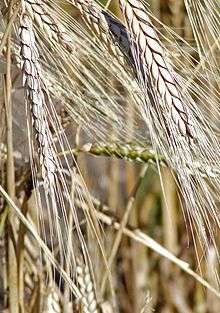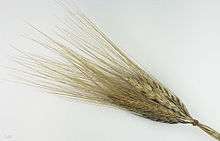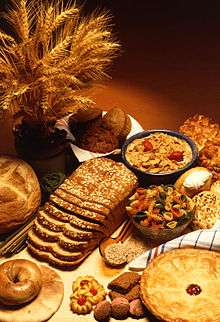Khorasan wheat
| Khorasan wheat | |
|---|---|
 | |
| Scientific classification | |
| Kingdom: | Plantae |
| Clade: | Angiosperms |
| Clade: | Monocots |
| Clade: | Commelinids |
| Order: | Poales |
| Family: | Poaceae |
| Subfamily: | Pooideae |
| Genus: | Triticum |
| Species: | T. turanicum |
| Binomial name | |
| Triticum turanicum Jakubz. | |
| Synonyms[1] | |
| |

Khorasan wheat or Oriental wheat (Triticum turgidum ssp. turanicum also called Triticum turanicum), commercially known as kamut, is a tetraploid wheat species.[2] It is an ancient grain type; Khorasan refers to a historical region in modern-day Iran in the northeast and parts of Central Asia including modern-day Afghanistan. This grain is twice the size of modern-day wheat and is known for its rich, nutty flavor.[3]
Taxonomy
Original botanical identifications were uncertain. The variety is a form of Triticum turgidum subsp. turanicum (also known as Triticum turanicum), usually called Khorasan wheat. Identifications sometimes seen as T. polonicum are incorrect as the variety, although long-grained, lacks the long glumes of this species. Recent genetic evidence from DNA fingerprinting suggests that the variety is perhaps derived from a natural hybrid between T. durum and T. polonicum, which would explain past difficulties in arriving at a certain classification.[3]
Life form
As an annual, self-fertilized grass that is cultivated for its grains, Khorasan wheat looks very similar to common wheat. However, its grains are twice the size of modern wheat kernel, with a Thousand-kernel Weight up to 60g. They contain more proteins, lipids, amino acids, vitamins and minerals than modern wheat.[4] The grain has an amber colour and a high vitreousness.[5]
History
The exact origin of Khorasan wheat remains unknown. Described by John Percival in 1921,[6] this ancient grain probably originates from the Fertile Crescent and derives its common name from the historical province of Khorasan which included a large portion of northeastern Iran into Afghanistan and Central Asia to the river Oxus. Some Turkish scientists have suggested that it originated in Anatolia.[7]
Khorasan wheat was probably continuously cultivated at small scales and for personal use in Near East and Central Asia and in Northern Africa.[8] However, it has not been commercially produced in modern times. In 1949, when the grain reached the USA, it did not raise a lot of interest and therefore fell into disuse. In 1977, Mack and Bob Quinn, two farmers from Montana, decided to cultivate this ancient grain. In 1990, they registered the protected cultivated turanicum variety QK-77 as the trademark Kamut.[9]
Region of cultivation
Khorasan wheat is grown in Europe mainly for bread, and in the Iranian province of Khorasan as food for camels.[10] It is also probably cultivated in small acreage and for personal use in some other regions of the Middle East.
Approximately 16,000 acres (6,500 ha) of Khorasan wheat were cultivated in 2006 in north-central Montana, southern Saskatchewan and southeast Alberta.[9] Experimental production has been made in Europe and in Australia.[9]
Yield
The actual average yield of Kamut brand Khorasan wheat is 1.1–1.3 t/ha. In drier years, Khorasan wheat can sometimes yield even more than durum wheat. However, in normal or wet years, it yields approximately 1/3 less than the durum wheat.
Distribution
Europe represents almost 70% of the 2006 sales and Italy was the greater consumer.[9] With only 16,000 acres (6,500 ha) cultivated worldwide, Khorasan wheat does not play an important role in the world food system. By capturing this niche market, Khorasan wheat counterbalances its weak agronomic traits.[11] Between 1998 and 2006 total sales of Kamut brand wheat increased by 72%.[9]
Product use
Khorasan wheat is used similarly as modern wheat. Its grains can be either directly consumed or milled into flour. It can be found in breads, bread mixes, breakfast cereals, cookies, waffles, pancakes, bulgur, baked goods, pastas, drinks, beer and snacks.[9] Apart from its nutritional qualities, Khorasan wheat is recognized for its smooth texture and nutty, buttery flavor.[4] Consumers generally like Khorasan wheat products for their visual appeal, texture and moistness.[12]
Nutrition and composition
Nutrients
| Nutritional value per 100 g (3.5 oz) | |
|---|---|
| Energy | 1,411 kJ (337 kcal) |
|
70.38 g | |
| Starch | 52.41 g |
| Dietary fibre | 9.1 g |
|
2.2 g | |
| Saturated | 0.192 g |
| Monounsaturated | 0.214 g |
| Polyunsaturated | 0.616 g |
|
14.7 g | |
| Vitamins | Quantity %DV† |
| Thiamine (B1) |
51% 0.591 mg |
| Riboflavin (B2) |
15% 0.178 mg |
| Niacin (B3) |
42% 6.35 mg |
| Pantothenic acid (B5) |
18% 0.9 mg |
| Vitamin B6 |
20% 0.255 mg |
| Vitamin E |
4% 0.6 mg |
| Minerals | Quantity %DV† |
| Iron |
34% 4.41 mg |
| Magnesium |
38% 134 mg |
| Manganese |
136% 2.86 mg |
| Phosphorus |
55% 386 mg |
| Potassium |
9% 446 mg |
| Zinc |
39% 3.68 mg |
| Other constituents | Quantity |
| Water | 10.95 g |
| |
|
†Percentages are roughly approximated using US recommendations for adults. Source: USDA Nutrient Database | |
In 100 grams, Khorasan wheat provides 337 calories and is a rich source (more than 19% of the Daily Value, DV) of numerous essential nutrients, including protein (29% DV), dietary fiber (46% DV), several B vitamins and dietary minerals, especially manganese (136% DV) (table). Khorasan wheat is 11% water, 70% carbohydrates, 2% fat and 15% protein (table).
Composition
Khorasan wheat has high protein content which improves its vitreousness[13] which indicates a high milling yield.[4]
Gluten
As kamut contains gluten, it is unsuitable for people with gluten-related disorders, such as celiac disease, non-celiac gluten sensitivity and wheat allergy sufferers, among others.[14]
Requirements for climate and soil
As Khorasan wheat is an ancient cereal species, the climatic requirements still correspond very well with its region of origin—i.e., the fertile crescent in the Middle East. A temperate continental climate with cold nights in the early spring (see vernalisation), low to moderate precipitation rates (500–1,000 mm per year), and a sunny warm summer for optimal ripening are therefore the typical preferred climatic conditions of Khorasan wheat. These conditions are very similar to those of durum wheat, which originates in the same region. But, because breeding efforts for Khorasan wheat have been very sparse (see chapter below), the adaptation to other climatic conditions is still limited.
In general Khorasan wheat seems to be less susceptible to environmental stress than common wheat, a characteristic it shares with most of the ancient grains.[11] Khorasan wheat is especially known for its drought tolerance, which is even better than that of durum wheat. Too much precipitation, especially in the end of the season, usually leads to dramatic disease problems (see chapter below).
Soils typically used for Khorasan wheat are the same as for durum wheat: deep friable black clays with a certain water storing capacity, also known as vertisols.[15]
Cultivation management, harvest and post-harvest treatment
The cultivation practices are quite similar to other wheat species, especially durum. As most of the Khorasan wheat is organically produced, the nutrient supply (especially nitrogen) should be granted by using an appropriate crop rotation, such as previous pasture legumes.[15] The nutritional content of Khorasan wheat is the most important characteristic of this crop and the reason why it is cultivated. Therefore the nutrition supply is one of the critical aspects of this production. Harvest in general follows the same procedure as in the other wheat species. As soon as the grains are mature, a combine harvester threshes the Khorasan wheat. But contrary to common wheat, the seeds of Khorasan wheat are very brittle and crack in half very easily, which leads to a necessarily more gentle harvest and post-harvest treatment.
Thinking of post-harvest treatments, the special physical properties of the Khorasan grain may cause difficulties (literature on that topic is still scarce). Storage may be more difficult because of a higher water capacity of the grains, the milling has to be adapted because of the big grains (should not be a problem in modern mills, in general) and the whole transportation machinery must deal with higher weight, because the Thousand Kernel Weight (TKW) is very high.
Growth, development, physiology
Khorasan wheat is a tetraploid wheat subspecies, which means that the general biological properties resemble those of durum wheat.
Diseases
The range of diseases in Khorasan wheat is more or less the same as in all other wheat species. Main diseases are typically caused by fungi, such as the Fusarium Head Blight or the "black tip". Khorasan wheat has been found very susceptible to Fusarium Head Blight.[2]
Because of the high susceptibility to fungi, crop rotation is quite important, especially under organic production conditions. The rotation requirements resemble more or less the ones of durum wheat.[15] Depending on the specific production setting, Khorasan production after maize or other cereals should be avoided. Typical robust rotations would contain some of the following crops: canola, sunflower, pulses, sorghum and pasture legumes.
Aspects of breeding
The traditional aim of plant breeding is to improve the agronomic or nutritional qualities of a crop. Typical goals are improved yield, reduced susceptibility to diseases and pests, homogeneous maturation (to optimize harvest) and increased tolerance to environmental stresses—i.e., drought, acid soil, high or cold temperature, etc. Most of the known wheat species today are polyploid.Whereas common bread wheat is hexaploid, Khorasan wheat is tetraploid.[11] To do further breeding with this tetraploid Khorasan wheat, the genetic pool to use is a little bit limited to the tetraploid subspecies of triticum turgidum such as Durum (subsp. durum), Polish (subsp. polonicum), Persian (subsp. carthlicum), Emmer (subsp. dicoccum) and Poulard (subsp. turgidum) wheat. Especially to develop resistances against common fungi (e.g. Fusarium Head Blight), this genomic pool is interesting. Problematic in this case, is the economic unimportance of most of the tetraploid subspecies of wheat (except Durum), which limits the investment to do intensive breeding, especially compared to the highly important common bread wheat.[2]
As mentioned above, until now the only commercial production of Khorasan wheat is done under the label of Kamut. Breeding is therefore not allowed, as the label requires remaining original. As the agronomic potential of Khorasan wheat still is quite low, breeding would be very interesting or even necessary. Probably, Khorasan wheat has to be pushed by Kamut first to become more interesting for other producers, which may then go into further breeding with other Khorasan cultivars.
See also
References
- ↑ "The Plant List: A Working List of All Plant Species".
- 1 2 3 Oliver R. E.; Cai X.; Friesen T. L.; Halley S.; Stack R. W.; Xu S. S. (2008). "Evaluation of Fusarium Head Blight Resistance in Tetraploid Wheat (Triticum turgidum L.)". Crop Science. 48 (1): 213–222. doi:10.2135/cropsci2007.03.0129.
- 1 2 Khlestkina, Elena K.; Röder, Marion S.; Grausgruber, Heinrich; Börner, Andreas (2006). "A DNA fingerprinting-based taxonomic allocation of Kamut wheat". Plant Genetic Resources. 4 (03): 172&ndash, 180. doi:10.1079/PGR2006120.
- 1 2 3 Amal M.H. Abdel Haleem; Henar A. Seleem; Wafaa K. Galal (2012). "Assessment of Kamut wheat quality". World Journal of Science, Technology and Sustainable Development. 9 (3): 194–203.
- ↑ Quinn, R.M (1999). "Kamut: Ancient grain, new cereal". In Janick, J. Perspectives on new crops and new uses. Alexandria: ASHS Press. pp. 182–183.
- ↑ "The Wheat Plant". Retrieved 17 August 2015.
- ↑ "Kamut Brand Khorasan Wheat". Retrieved 17 November 2013.
- ↑ Vavilov, N.I. (1951). The origin, variation, immunity and breeding of cultivated plants. Waltham MA: Chronica Botanica Co.
- 1 2 3 4 5 6 Gary W. Brester; Brenna Grant; Michael A. Boland (2009). "Marketing Organic Pasta from Big Sandy to Rome: It's a Long Kamut". Review of Agricultural Economics. 31 (2): 359–369. doi:10.1111/j.1467-9353.2009.01442.x.
- ↑ Karimi, H. (1992). Wheat. Iran University Press.
- 1 2 3 Singh, Av (Winter 2007). "Ancient Grains, a wheat by any other name". The Canadian Organic Grower.
- ↑ A. Katz; A. David; I.T Forrester (September 2012). "Rare Khorasan wheat provides a nutrient-dense substitution for all-purpose white flour with no palatability issues". Journal of the Academy of Nutrition and Dietetics. 112 (9).
- ↑ El-Rassas, H.N.; Atwa, M.F.; Mostafa, K.M. (1989). "Studies on the effect of gamma rays on the technological characteristics of some Egyptian wheat varieties". Faculty Journal of Agricultural Research Development. 3 (1): 1–21.
- ↑ Tovoli F, Masi C, Guidetti E, Negrini G, Paterini P, Bolondi L (Mar 16, 2015). "Clinical and diagnostic aspects of gluten related disorders". World J Clin Cases. 3 (3): 275–84. doi:10.12998/wjcc.v3.i3.275. PMC 4360499. PMID 25789300.
- 1 2 3 Kneipp J. (2008), Durum wheat production, State of New South Wales through NSW Department of Primary Industries - Tamworth Agricultural Institute, Calala
Further reading
- Sacks, Gordon (2005). "Kamut: A New Old Grain". Gastronomica. 5 (4): 95–98. doi:10.1525/gfc.2005.5.4.95. JSTOR 10.1525/gfc.2005.5.4.95.
- Quinn, R.M. (1999). "Kamut: Ancient grain, new cereal". In Janick, J. Perspectives on new crops and new uses. ASHS Press, Alexandria. pp. 182–183.
- Rodríguez-Quijano, Marta; Lucas, Regina; Ruiz, Magdalena; Giraldo, Patricia; Espí, Araceli; Carrillo, José M. (2010). "Allelic Variation and Geographical Patterns of Prolamins in the USDA-ARS Khorasan Wheat Germplasm Collection". Crop Science. 50 (6): 2383&ndash, 91. doi:10.2135/cropsci2010.02.0089.
External links
| Wikimedia Commons has media related to Triticum turgidum. |
